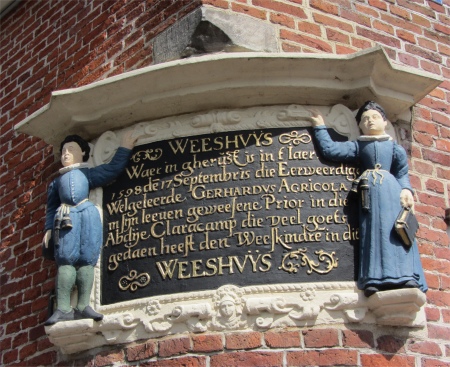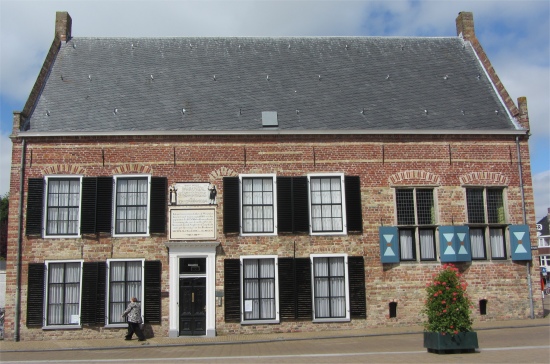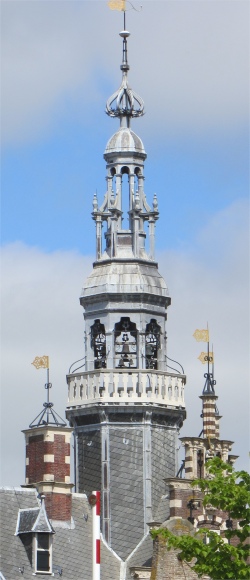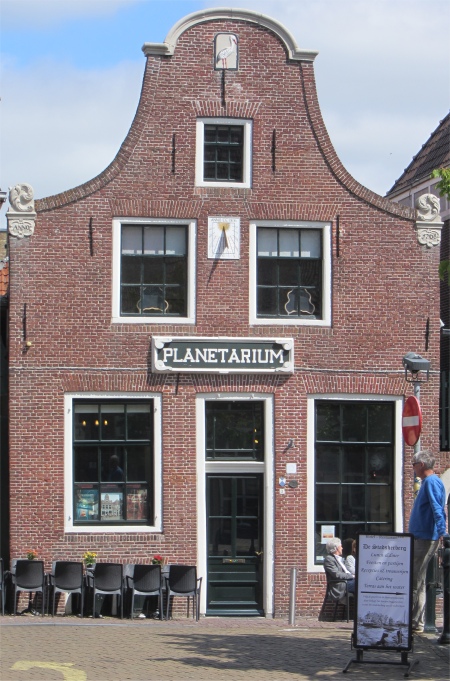I had some concerns over the ferry costs to Terschelling, and sought translational guidance from the harbour master, who today was a lady. She was very informative, and because of the possibility of a rush demand for tickets to a festival on Terschelling, she recommended checking availability and booking over the internet. I followed her advice and discovered that we could get tickets to the island at our preferred time of 09:45, but the only ferry we could catch back would be at 12:30; hardly worth going.
 Stone with Inscription and Relief of an Orphan Boy and Orphan Girl |
 Typical Frakener Building with Stone Inscription and Relief |
Rex fumed for a while over the map issue. "Nelson never had this trouble," he said. Throughout the course of the trip he would often repeat those words in complete humour, usually aimed at me and Meryl. But we would give back as good with "Hardy never had this trouble," or "Lady Hamilton never had this trouble," all good banter.
By noon we found ourselves at the small train station in Harlingen, waiting to catch a train to Franeker. As we approached the ticket machine, we were accosted by an odd couple, who we learned were an old Dutch man and a Japanese woman. It turned out the two were actually unconnected, the old man was trying to help the young woman, and we three Brits were roped in to help resolve how she should reach the Old Station in Den Haag. According to the ticket dispenser, there was no Old Station. I took her to the information office and left her to try and communicate, in whatever language she could, with the young female official. A while later, when we boarded our train, we observed her at the same ticket dispenser accosting another group of people. I hoped she could get to where she wanted.
 Carillon above the Stadhuis |
The town of Frakener was heralded by industrial zones and the Van Harinxmakanaal. Alighting at the small station, more of a platform than a station, we strolled over the canal bridge and into the town, passing handsome gabled houses.
Franeker first appeared in the records in 1085; in the 12th century it was surrounded by walls and a moat; and it received a municipal charter in 1417. It is a charming little town with its ring of canals and its fine old buildings. Franeker is also noted for the Eise Eisinga Planetarium. A university, the second in the Netherlands, after Leiden, was founded in Franeker in 1585, making it the cultural center of the north of the country. The most celebrated student of the Frisian Academy was the French philosopher Descartes. The university was dissolved by Napoleon in 1811 and was replaced in 1815 by an Athenaeum, which continued in existence until 1843. Franeker is also one of the historical eleven cities.
 Stadhuis |
The central feature of Franeker is St Martinikerk, an aisled pseudo-basilica (consecrated 1421), with the aisles continued by an ambulatory round the choir. The barrel-vaulted timber roof is borne on 30 columns. Tombstones of university professors lay here, and the Gothic choir-stalls were quite impressive.
100m or so away we came across the impressive Stadhuis (Town Hall). The Renaissance Town Hall in Raadhuisplein, built in 1591, has a richly decorated facade, with coats of arms, and a handsome external staircase. The roof has three stepped gables and is topped by an elegant octagonal tower. A carillon in the bell tower periodically played classical pieces of music.
Just opposite the Stadhuis at Eise Eisingstraat 3, was an unpretentious house containing a feature which in its day was famed far beyond the bounds of Friesland, a planetarium constructed in 1774-81 by Eise Eisinga.
The highly gifted Eisinga was not allowed to attend the Latin School because he was expected to become a wool comber like his father before him. All on his own, he immersed himself in the study of the principles of maths and astronomy. The fact that the Franeker Academy was close by suited him well. Indeed he was so gifted that he wrote a book on mathematics at the age of 15, a copy of which was in the planetarium museum.
 Eise Eisinga Planetarium |
Just like many other men of his time, Eisinga was inspired by the Enlightenment. These men were convinced that knowledge could improve both mankind and society. Enlightenment thinkers in the Netherlands were different in nature to those in France. Living in a country with no all-powerful church or absolute ruler meant that few Dutch citizens were sympathetic to the radical and anti-clerical views of some French philosophes. Rather, they believed that God wanted the best for the world: He was leading all things towards a friendly, harmonious society. They therefore immersed themselves in enjoyable social interaction. Together with other responsible citizens they conducted experiments in physics, they examined fossils, discussed solutions for social problems and studied heavenly bodies.
Even today Eisinga's planetarium shows the current position of the planets. All this is kept in motion by an impressive gear mechanism of wooden rings and discs with ten thousand hand-forged nails as cog teeth. A pendulum clock and nine weights drive the gear mechanism. The lady who gave us a potted history of the planetarium told us how Eisinga's wife had complained that one of the main pendulums, which swung over their bed, was too long for comfort. Eisinga dutifully altered his system to allow the pendulum to be shortened.
When King William I came to Friesland in 1818 to visit the planetarium, he was so impressed that he subsequently bought it for the Dutch state. Ten years later, in 1828, Eisinga died aged 84. In his will he described the mechanism of his planetarium.
Various time keeping and astronomical instruments were also on display in the museum, but the piece de resistance was looking up at the sky blue planetarium in the ceiling, and also being allowed to have a peek at the complex of cogs and pulleys that drove this marvellous "machine". It must have been mind blowing at the time.
We sipped cups of sustenance at a cafe just outside the planetarium, my cup containing a herb flavoured tea that tasted of gnats wee. From this vantage point we watched the world go by a while, a wedding party climbed the Stadhuis steps, the chiming carillon soothed our minds, and we just soaked up the atmosphere.
Then it was off down Voorstraat where a street market was in full swing, packed with stalls selling meats, cakes, cheeses, freshly cooked fish and a host of other things. Rex was more interested in finding a hardware shop to buy a funnel to facilitate pouring oil into the boat engine. Meryl was content to buy some apple tarts from one of the stalls.
 Kaatsen Tournament, with One of the P.C. Towers in the Background, and the Bogt van GunéG in front of the Crane |
We had the rules explained to us three times by well-wishing spectators, parents of the girls playing. Friesland handball is played on a rectangular lawn of 61m by 32m by two teams of 3 players. In the centre of one short side of the field is a receiving zone of 5m by 19m defended by 2 players, the other team member remaining a field player. One of the opponents serves the hard leather ball with his bare hand from a serving box at about 30m from the receiving zone. If he does not succeed in reaching the receiving zone, the receiving team gets a direct score. When the receiving team, of which the players are allowed to wear a single hardened leather glove, returns the ball over the short line behind the serving box (called the upper line, in Friesland speak) they also get a direct score. Of course, the serving team is allowed to prevent this happening by hitting or holding the ball before the upper line. The place where the ball remains after such a rally is marked with a small woodblock called a kaats, which is best defined as an undecided score. When two such undecided points occur (or one, if one of the teams is on game point) the teams change places. In the next rally, the team that then has the receiving position, tries to hit the ball past the first kaats and, if any, in the next rally past the second kaats, so deciding the undecided points. Then they start all over again.
 Choir at the City Proms |
Once we'd had our fill of this, to me bewildering, game, we wandered down to the two tall P.C. Towers at the Voorstraat end of the pitch to view the photos of the P.C. tournament through the glass surround. During the final, the pitch surround is converted to a proper stadium, an impressive affair.
We wound our way back to the town square and watched a couple of performances from the City Proms on a stage, a touring version of The Proms featuring local musicians. We lingered for a few classical pieces from a Philharmonic Orchestra, which were slightly off-key at times but played with enthusiasm. Sadly the cold wind, that was now blowing through the town, encouraged us to head back to Harlingen
The Japanese woman was no longer there seeking a way to the non-existent Old Station in Den Haag. Perhaps she was the decaying corpse in the corner clutching an unused ticket.
In the evening we enjoyed a splendid meal in a cosy restaurant by the Nooderhaven, a convivial place where Rex excelled in his mastery of Dutch. The waitress was most impressed. A walk around the harbour rounded off the day nicely.
